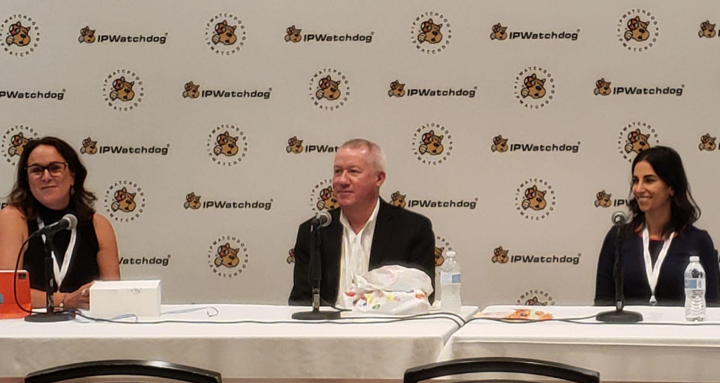“E-commerce monitoring is absolutely crucial. You need to know if your company’s products are being sold internationally – it is money well spent and may generate valuable business intelligence.” – Mark Leonard

From left: Jayne Durden, Mark Leonard and Heather Antoine
On the Monday of IPWatchdog LIVE last week, a panel of trademark experts discussed “International Trademark Rights: Best Practices for a Trademark Global Presence,” moderated by vice president of law firm strategy for Anaqua, Jayne Durden. The speakers included Mark Leonard, general counsel for the Jelly Belly Candy Company, and Heather Antoine, partner at Stubbs Alderton & Markiles and chair of the California Lawyers Association IP Section.
Brand Value and E-commerce
Kicking off the discussion, Jayne Durden informed the audience that the value of brands has massively skyrocketed in recent years. For instance, the top ten brands over the last ten years, most of which include tech brands such as Apple, have grown on average four times in value, thus leading to a greater need for trademark protection. In the last quarter alone, said Durden, the filing of trademark applications has increased a whopping 49%.
Agreeing with these statistics, Mark Leonard noted that trademarks are a marketing tool for brands, and the single biggest driver of the market affecting brands currently is e-commerce. Brand owners should be aware that “most of your consumers are looking at your product on a 3.5-inch screen.”
Global Trademark Protection: When is it Necessary?
E-commerce comes with its challenges though, one being that, due to an uptick in e-commerce, many brand owners want trademark registrations in every country possible despite funding issues, and even where unnecessary. Antoine tells some clients that this isn’t necessarily the right strategy: “Registering your trademark everywhere is probably way out of your league. It needs to be specific. The question is, where is the next place you’re going?”
In response to a question from the audience about how to advise a hypothetical client with a $50,000 budget, Durden offered the following advice:
I’d be having a conversation [about whether] they had a patentable idea. If they have the budget, you want to protect the patent while also protecting the trademark. Unlike with patents, you can always file a trademark later, because a trademark registration does not preclude you later from filing use-based applications. Being clever and playing with the budget is a good discussion.
Madrid Protocol Considerations
So, what do you do when you do have a client who is determined to file everywhere, who doesn’t necessarily have the same kind of budget? Antoine brought up the Madrid Protocol. The Madrid Protocol is an international treaty designed to make global trademark registration easier and less expensive for registrants. Under this process, registrants are able to complete a single application, in their home language, that can then be applied to over 90 member countries. However, offering words of caution, she noted that utilizing the Madrid Protocol isn’t always fool proof. According to Antoine, it may still be best to file in individual countries if there is any risk that the registration in your home country is cancelled, because this base registration is the building block on which foreign registrations are based:
Let’s say the U.S. is your home country and you obtain a registration with the U.S. and use that with the EU, Canada, etc. If something happens where your mark is cancelled in your home country, your mark is a wash . . . I would file in every country, that way if something goes wrong [in your home country] you won’t lose your trademark [in foreign countries].
Leonard partially joined this sentiment, adding: “If that registration is invalidated for any reason then, poof, all of a sudden all of your registrations go away.” However, he also discussed the benefits of the Madrid Protocol, and how it’s conceivable to obtain registrations in, say, 15 countries for $2,000, which could otherwise cost upwards of $30,000 if filed individually. The only exception to this in his mind is regarding China: “Never file a Madrid [Protocol] application to China,” he said.
Critical Cultural Considerations and Enforcement Approaches
The panel then moved on to the importance of cultural considerations when filing a mark in foreign countries. These considerations are critical to success, noted the panel, so registrants have to ask, how is this mark going to translate to consumers in a foreign country? For example, Leonard discussed a classic example from Pepsi in the 1960s, in which a seemingly well-meaning slogan “choice of a new generation” was translated in Chinese to mean “brings your ancestors back to life.” To get around this, the panel recommended hiring a language specialist, as well as discussing any new trademarks with distributors or others who may have insight into the language.
Lastly, the panel shifted to discussing approaches to trademark infringement and how it crosses over with individual cultures. The panel noted that sometimes it’s necessary to take a heavy-handed or “scorched earth” approach to infringement, such as taking serious enforcement actions against the infringer, whereas sometimes it’s necessary to take a softer approach, such as reaching out to the infringer to discuss the infringement. Antoine had the following advice:
I think it depends on where [in the world] you are on whether you take a scorched earth approach or a gentle approach, and here in the US a kinder and gentler approach works well. But sometimes that doesn’t work well . . . and in other jurisdictions, for example the UK, I’ve been told to tone it down. I think it’s a very subjective thing in each case on its own.
Leonard also offered his two cents: “I agree with that, and you have to look at the degree and nature of the infringement.” Using examples from his work at Jelly Belly, Leonard noted that a scorched earth approach was necessary to contain an infringing product that not only infringed the Jelly Belly name, but also its trade dress. The infringing product from China changed only one letter in the product name, reading “Belly Belly,” and therefore a heavy-handed approach was necessary to stop the infringement. In contrast, using another example from his work at Jelly Belly, he pointed to a nutritional product from the EU that infringed just the Jelly Belly trademark. Even though the nutritional product titled “Jelly Belly” was clearly infringing the Jelly Belly trademark, he felt that taking a soft approach would be more effective in this case because the product did not copy Jelly Belly’s trade dress and came from the EU. “There is no one size approach to enforcement,” said Leonard.


Final Tips to Registrants
In wrapping up, the panelists offered the following advice to attendees. First, “e-commerce monitoring is absolutely crucial,” Leonard said. “You need to know if your company’s products are being sold internationally – it is money well spent and may generate valuable business intelligence.”
And secondly, “remember trademarks!” Antoine urged. “They are valuable and they bring a lot of benefits to brands.”
For more trademark tips, tune in this Thursday, September 23, to IPWatchdog’s webinar, “The Global Fight Against Counterfeits: Business Reality and Enforcement Strategies,” sponsored by Anaqua.

![[IPWatchdog Logo]](https://ipwatchdog.com/wp-content/themes/IPWatchdog%20-%202023/assets/images/temp/logo-small@2x.png)

![[Advertisement]](https://ipwatchdog.com/wp-content/uploads/2024/04/Patent-Litigation-Masters-2024-sidebar-early-bird-ends-Apr-21-last-chance-700x500-1.jpg)

![[Advertisement]](https://ipwatchdog.com/wp-content/uploads/2021/12/WEBINAR-336-x-280-px.png)
![[Advertisement]](https://ipwatchdog.com/wp-content/uploads/2021/12/2021-Patent-Practice-on-Demand-recorded-Feb-2021-336-x-280.jpg)
![[Advertisement]](https://ipwatchdog.com/wp-content/uploads/2021/12/Ad-4-The-Invent-Patent-System™.png)







Join the Discussion
No comments yet.